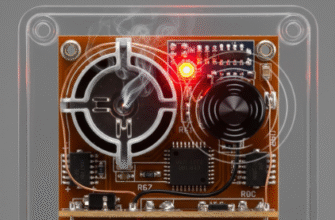Ever peered through a pair of binoculars and felt that little jolt of wonder as a distant bird, boat, or landmark suddenly leaps into view? It feels almost like magic, shrinking the miles in an instant. But behind this everyday marvel lies some clever, yet fundamentally straightforward, physics involving light and lenses. Basic binoculars don’t actually pull objects closer; instead, they magnify the light coming *from* those objects, making them appear larger and thus, closer to our eyes.
The Stars of the Show: Objective Lenses
The journey of light through binoculars begins at the front, with the large lenses facing the object you’re observing. These are called the objective lenses. Their primary job isn’t magnification, but rather light gathering. Think of them like wide-open windows collecting as much light as possible from the distant scene. The larger the diameter of these lenses (often measured in millimeters, like the ’42’ in 8×42 binoculars), the more light they can gather. More light generally means a brighter, clearer image, especially in dimmer conditions like dawn or dusk.
As light rays from the distant object pass through the objective lens, the curved shape of the glass bends these rays, converging them to form a focused, but small and crucially, inverted (upside-down and reversed left-to-right) image inside the binocular tube. The distance from the objective lens to the point where this image forms is its focal length. Longer focal lengths generally produce a higher potential magnification later on.
Making it Big: The Eyepiece Lenses
At the other end, where you place your eyes, are the eyepiece lenses (or ocular lenses). These act like powerful magnifying glasses. Their job is to take that small, inverted image formed by the objective lens and enlarge it significantly, presenting it to your eyes. The eyepiece lens has a much shorter focal length compared to the objective lens.
The magnification power of the binoculars – the ‘8x’ in our 8×42 example, meaning objects appear eight times closer – is determined by the ratio of the objective lens’s focal length to the eyepiece lens’s focal length. If the objective lens has a focal length of 400mm and the eyepiece has a focal length of 50mm, the magnification would be 400 / 50 = 8x. The eyepiece effectively zooms in on the initial image created by the objective.
Flipping Out: The Role of Prisms
So, we have light gathered and an image formed by the objective, then magnified by the eyepiece. But there’s a snag: that initial image is upside-down and backwards. Looking through a simple two-lens system like this would give you a magnified, but disorientingly inverted, view of the world. This is where prisms come in – they are the unsung heroes inside most binoculars.
Basic binoculars typically use one of two main prism systems to correct the image orientation:
Porro Prisms
Named after their inventor, Ignazio Porro, these prisms are usually arranged in a distinctive Z-shaped configuration within each barrel of the binoculars. Light enters the first prism, reflects internally off two surfaces, gets flipped, and then enters the second prism, where it reflects twice more, flipping again. The result of these multiple reflections is that the image is corrected both vertically and horizontally. It also has the effect of folding the light path, allowing the binoculars to be shorter than a simple telescope of the same magnification would need to be. Binoculars using Porro prisms often have that classic, wide-bodied shape where the objective lenses are offset from, and wider apart than, the eyepieces.
Roof Prisms
Roof prisms perform the same image-correcting function but use a more complex arrangement of prisms (often Schmidt-Pechan or Abbe-Koenig designs) that allows the light to travel in a straighter path. This results in binoculars that are typically slimmer, more compact, and have their objective lenses directly in line with the eyepieces. While offering a more streamlined design, manufacturing roof prisms requires extremely precise alignment and high-quality coatings (like phase correction coatings) to maintain image brightness and sharpness comparable to good Porro prisms. This often makes roof prism binoculars more expensive.
Prism Power: Prisms are essential not just for turning the image the right way up, but also for folding the light path. This allows binoculars to achieve significant magnification within a relatively compact body. Without prisms, binoculars would need to be much longer, like old naval spyglasses.
Regardless of the type, the prisms sit between the objective lens and the eyepiece lens. The inverted image formed by the objective lens enters the prism system, gets flipped and turned the right way round, and then this corrected image is presented to the eyepiece lens for magnification.
Bringing It All Together: The Light Path
Let’s trace the journey one more time:
- Light rays from a distant object travel towards the binoculars.
- They enter the large objective lens, which gathers the light and bends it to form a small, inverted, and reversed image inside the tube.
- This inverted image then enters the prism system (either Porro or Roof).
- Through a series of internal reflections within the prisms, the image is flipped vertically and horizontally, becoming correctly oriented.
- This corrected, still small image exits the prisms and enters the eyepiece lens.
- The eyepiece acts like a magnifier, enlarging this corrected image significantly.
- Your eye looks through the eyepiece and perceives this magnified, correctly oriented image, making the distant object appear much closer.
Focusing: Getting Sharp
Of course, objects aren’t always at the same distance. To get a sharp image, you need to focus. Most binoculars have a central focus wheel located between the two barrels. Turning this wheel subtly moves the eyepiece lenses (or sometimes the objective lenses or an internal lens group) slightly forwards or backwards relative to the prisms and the objective lenses. This adjustment changes the point where the light converges, allowing you to bring objects at different distances into sharp focus. Many binoculars also have a diopter adjustment, usually on one eyepiece, to compensate for differences in vision between your two eyes, ensuring the image is perfectly sharp for both.
A Word on Coatings: While we’re talking basic principles, lens coatings are vital even in entry-level binoculars. Uncoated glass reflects a significant portion of light, leading to dimmer images and internal reflections (ghosting/flare). Anti-reflection coatings applied to lens surfaces increase light transmission, improving brightness, contrast, and overall image quality. Even basic models benefit greatly from being at least ‘fully coated’ (all air-to-glass surfaces coated once).
Simple Physics, Big Impact
So, while it might seem like pure wizardry, the way basic binoculars make distant objects appear closer boils down to a clever application of optical principles. It’s a two-stage process: gather light and form an initial image with the objective lens, then correct the orientation using prisms, and finally magnify that corrected image with the eyepiece lens. The size of the objective lenses dictates brightness, the ratio of focal lengths dictates magnification, and the prisms ensure you see the world the right way up. It’s a beautiful combination of glass, geometry, and light doing its thing.







